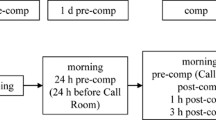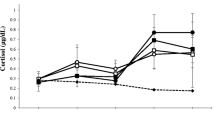Abstract
Mood and basal hormone levels were measured before and after a 4-month training period in 20 professional basketball players on 2 different teams. Training volume was daily quantified by intensities, showing that Team 1 trained nearly twofold the volume of Team 2. Apart from the lack of differences between teams in anthropometric and physical variables, results showed mood improvements in the total sample without differences between teams. However, cortisol levels decreased in Team 1 and increased in Team 2, while the free testosterone–cortisol ratio, free testosterone, prolactin, and luteinizing hormone did not show significant changes. Changes in cortisol were positively related to depression and negatively related to training volume. Results suggest that differences exist in sensitivity and/or timing of both psychological and hormonal responses to 2 given volumes of training.
Similar content being viewed by others
REFERENCES
Adlercreutz, H., Härkönen, M., Kuoppasalmi, K., Näveri, H., Huhtamieni, H., Tikkanen, H., Remes, K., Dessypris, A., & Karvonen, J. (1986). Effect of training on plasma anabolic and catabolic steroid hormones and their responses during physical exercise. International Journal of Sports Medicine, 7, 27–28.
Arce, J. C., & De Souza, M. J. (1993). Exercise and male factor infertility. Sports Medicine, 15, 146–169.
Bonifazi, M., Bela, E., Carli, G., Lodi, L., Martelli, G., Zhu, B., & Lupo, C. (1995). Influence of training on the response of androgen plasma concentrations to exercise in swimmers. European Journal of Applied Physiology, 70, 109–114.
Bosco, C., Colli, R., Bonomi, R., Von Duvillard, S. P., & Viru, A. (2000). Monitoring strength training: neuromuscular and hormonal profile. Medicine and Science in Sports and Exercise, 32, 202–208.
Chin, A. K., & Evonuck, E. (1971). Changes in plasma catecholamine and corticosterone levels after muscular exercise. Journal of Applied Physiology, 30, 205–207.
Fry, A. C., & Kraemer, W. J. (1997). Resistance exercise overtraining and overreaching neuroendocrine responses. Sports Medicine, 23, 106–129.
González-Bono, E., Salvador, A., Ricarte, J., Serrano, M. A., & Arnedo, M. (2000). Testosterone and attribution of successful competition. Aggressive Behavior, 26, 235–240.
González-Bono, E., Salvador, A., Serrano, M. A., & Ricarte, J. (1999). Testosterone, cortisol, and mood in a sports team competition. Hormones and Behavior, 35, 55–62.
Guezennez, Y., Leger, L., Lhoste, F., Aymonod, M., & Pesquies, P. C. (1986). Hormone and metabolite response to weight-lifting training sessions. International Journal of Sports Medicine, 7, 100–105.
Häkkinen, K., Pakarinen, A., Alén, M., Kauhanen, H., & Komi, P. V. (1988). Daily hormonal and neuromuscular responses to intensive strength training in 1 week. International Journal of Sports Medicine, 9, 422–428.
Hooper, S. L., Mackinnon, L. T., & Hanrahan, S. (1997). Mood states as an indication of staleness and recovery. International Journal of Sport Psychology, 28, 1–12.
Hubert, W., Möller, M., & Nieschlag, E. (1989). Stress reactions in response to the procedure of LHRH tests as measured by salivary and serum cortisol and psychological variables. Hormone Research, 32, 198–202.
Lehmann, M., Gastmann, U., Petersen, K. G., Bachl, N., Seidel, A., Khalaf, A., Fischer, S., & Keul, K. (1992). Training-overtraining: performance, and hormone levels, after a defined increase in training volume versus intensity in experienced middle-and long-distance runners. British Journal of Sports Medicine, 26, 233–242.
Lopez-Calbet, J. A., Navarro, M. A., Barbany, J. R., Garcia-Manso, J., Bonnin, M. R., & Valero, J. (1993). Salivary steroid changes and physical performance in highly trained cyclists. International Journal of Sports Medicine, 14, 111–117.
McDowell, S. L., Hughes, R. A., Hughes, T. J., & Johnson, G. O. (1992). The effect of exercise training on salivary immunoglobulin A and cortisol responses to maximal exercises. International Journal of Sports Medicine, 13, 577–580.
McNair, M. D., Lorr, M. and Droppleman, L. F. (Eds.). (1971). How to use the Profile of Mood States (POMS) in clinical evaluations. San Diego: Educational and Industrial Testing Service.
Morgan, W. P., O'Connor, P. J., Ellickson, K. A., & Bradley, P. W. (1988). Personality, structure, mood states, and performance in elite male distance runners. International Journal of Sport Psychology, 19, 247–263.
Moya-Albiol, L., Salvador, A., Costa, R., Martinez-Sanchis, S., González-Bono, E., Ricarte, J., & Arnedo, M. (2001). Psychophysiological responses to the Stroop task after a maximal cycle ergometry in elite sportsmen and physically active subjects. International Journal of Psychophysiology, 40, 47–59.
Moya-Albiol, L., Salvador, A., González-Bono, E., Martínez-Sanchis, S., & Costa, R. (2001). The impact of exercise on hormone is related to autonomic reactivity to mental task. International Journal of Stress Management, 8, 215–229.
O'Connor, P. J., Morgan, W. P., & Raglin, J. S. (1991). Psychobiologic effects of 3 d of increased training in female and male swimmers. Medicine and Science of Sports and Exercise, 23, 1055–1061.
Petruzzello, S. J., & Tate, A. K. (1997). Brain activation, affect, and aerobic exercise: An examination of both state-independent and state-dependent relationships. Psychophysiology, 34, 527–533.
Raglin, J. S., Morgan, W. P., & O'Connor, P. J. (1991). Changes in mood states during training in female and male college swimmers. International Journal of Sports Medicine, 12, 585–589.
Rowbottom, D., Keast, P., Garcia-Webb, P., & Morton, A. R. (1997). Training adaptation and biological changes among well-trained male triathletes. Medicine and Science of Sports and Exercise, 29, 1233–1239.
Salvador, A., Ricarte, J., Gonzalez-Bono, E. & Moya-Albiol, L. (2001). Effects of physical training on endocrine and autonomic response to acute stress. Journal of Psychophysiology, 15, 114-121.
Seidman, D. S., Dolev, E., Deuster, P. A., Burstein, R., Arnon, R., & Epstein, Y. (1990). Androgenic response to long-term physical training in male subjects. International Journal of Sports Medicine, 11, 421–424.
Suay, F., Ricarte, J., & Salvador, A. (1998). Indicadores psicológicos de sobreentrenamiento y agotamiento. Revista de psicología del Deporte, 13, 7–25.
Suay, F., Sanchis, C., & Salvador, A. (1997). Marcadores hormonales del síndrome de sobreentrenamiento. Revista de Psicolog´a del Deporte, 11, 21–39.
Tsai, L., Johansson, C., Pousette, A., Tegelman, R., Carlström, K., & Hemmingsson, P. (1991). Cortisol and androgen concentrations in female and male elite endurance athletes in relation to physical activity. European Journal of Applied Physiology, 63, 308–311.
Urhausen, A., Gabriel, H., & Kindermann, W. (1995). Blood hormones as markers of training stress and overtraining. Sports Medicine, 20, 251–276.
Urhausen, A., Kullmer, T., & Kinderman, W. (1987). A 7-week follow-up study of the behavior of testosterone and cortisol during the competition period in rowers. European Journal of Applied Physiology, 56, 528–533.
Uusitalo, A. L., Huttunen, P., Hanin, Y., Uusitalo, A. J., & Rusko, H. K. (1998). Hormonal responses to endurance training and overtraining in female athletes. Clinical Journal of Sport Medicine, 8, 178–186.
Vervoorn, C., Quist, A. M., Vermulst, L. J. M., Erich, W. B. M., de Vries, W. R., & Thijssen, J. H. H. (1991). The behaviour of the plasma free testosterone/cortisol ratio during a season of elite rowing training. International Journal of Sports Medicine, 12, 257–263.
Viru, A., & Smirnova, T. (1982). Independence of physical working capacity from increased glucocorticoid level during short-term exercise. International Journal of Sports Medicine, 3, 80–83.
von Zerssen, D., Doerr, P., Emrich, H. M., Lund, R., & Pirke, K. M. (1987). Diurnal variation of mood and the cortisol rhythm in depression and normal states of mind. European Archives in Psychiatry and Neurological Science, 237, 36–45.
Wheeler, G. D., Singh, M., Pierce, W. D., Epling, W. F., & Cumming, D. C. (1991). Endurance training decreases serum testosterone levels in men without change in luteinizing hormone pulsatile release. Journal of Clinical Endocrinology and Metabolism, 72, 422–425.
Author information
Authors and Affiliations
Rights and permissions
About this article
Cite this article
González-Bono, E., Salvador, A., Serrano, M.A. et al. Effects of Training Volume on Hormones and Mood in Basketball Players. International Journal of Stress Management 9, 263–273 (2002). https://doi.org/10.1023/A:1019978115419
Issue Date:
DOI: https://doi.org/10.1023/A:1019978115419




